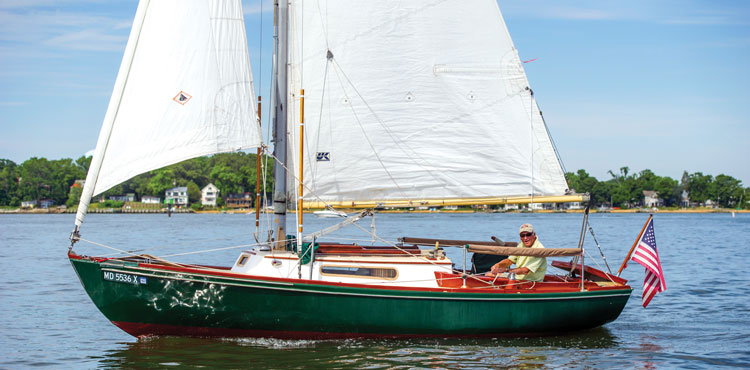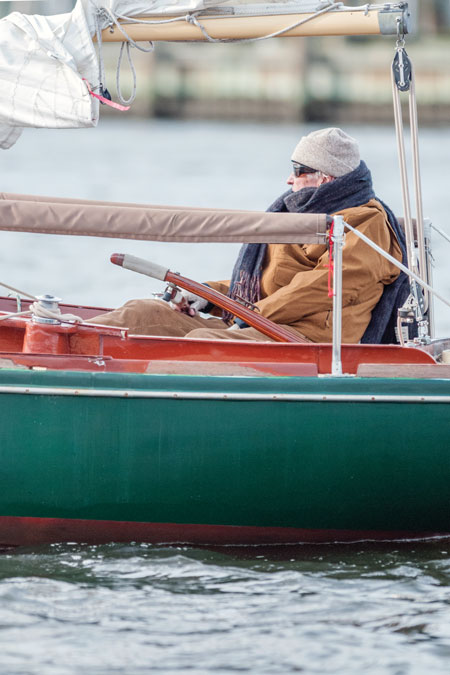by Dave Gendell
Free at last, free at last! After four months of winter imprisonment in a DIY boatyard, my classic sailboat was unchained from a work bed of dirt and stone April 10 and returned to its natural element. As we motored away... I released a loud ‘Yee-hah!’ and waved farewell to any who might be listening and watching.
Jack Sherwood, 2012
I could not help speculating upon what might lie farther up the river.
Samuel Butler, “Erewhon” 1872
Jack Sherwood passed away on December 7, 2016 at age 84 after a short but intense bout with cancer. Jack was an authentic and honest writer and an ironman of a sailor. He spent his entire 55-year professional career as a storyteller, the second half of it focused exclusively on the waterfront beat. At the same time, he lived more than half of his life as an obsessed sailor: in love with the waterfront. In love with his boat. In love with the wind.
For some, Jack and his 22-foot sloop Erewhon were simply a pleasant backdrop; part of the Annapolis waterfront fabric alongside the Harbor Queen, the Woodwinds, or a fleet of Optis poking through the mooring field. A handsome green boat sailed by a handsome silver-haired man against a shiny blue background. Isn’t this a charming little town?
But for the sailors, the sight of Jack on the water triggered something entirely different. For those of us who understood—and I suspect there are many in Annapolis and along the Chesapeake Bay who get it—Jack and his sloop, departing or arriving on Spa Creek, became a regular reminder that we should be out sailing more. There goes Jack, out sailing again... what are we doing here on shore, waiting on the damn bridge, getting stale inside a swollen SUV?
The message quietly delivered by the picture of Jack and his boat was as uncomplicated as it was obvious: we need to get out there.
At the same time, Jack’s published stories of sailing and the characters he encountered along the way made us understand and long for a sort of parallel maritime world that was colorful, vibrant, and occasionally, pleasantly strange. It was as if Jack was tuned to a different frequency that delivered him these stories, allowed him to tap into them, share them with us, and make us love them as much as he did.
Jack Sherwood was an old school sort of writer—his skills learned and honed at daily newspapers, not at some fancy university or in a seminar. He could write fast without any drama. He could write to a tight word count with no complaining. He avoided delivering messages or morals in his work. And he could write pretty much anywhere. He simply sat down and cranked it out. Jack’s sentences were lean, strong, and purposeful. A newspaper reporter’s style.
Jack started his career in newspapers in 1960 and spent nearly 20 years at the Washington Star as a columnist and feature writer. He also spent time on the staff at the Baltimore Sun and the Miami Herald. Later, he served as an editor at Rags magazine in Annapolis and then spent several years with Chesapeake Bay Magazine. In the late 1990s, he joined the team at Soundings magazine as a senior staff writer and continued to produce features and a first-person column under the header “Bay Tripper.” He semi-retired in 2005 but continued to write his Bay Tripper column until declining health forced him to stop.
Jack’s skills as a writer were underpinned by his love of a good story and his love of characters. Jack sought out and celebrated the more colorful characters along the margin of the waterfront scene. And he could find them. When a big regatta arrived in Annapolis you might find Jack interviewing the photo-boat driver instead of the winning skippers, and the driver’s story would usually turn out to be far more interesting than the racer’s. Jack was never judgmental and always set his subjects in a good light.
Jack’s acclaimed book, “Maryland’s Vanishing Lives,” was published in 1994 by the Johns Hopkins University Press and has had multiple printings in hardcover and paperback. The beautiful book is an elegiac collection of stories and photos celebrating unique personalities in Jack’s unique voice and style.
Jack often put his own nautical misadventures in the center of his stories with frequently referenced tales of “dumpster diving” at the marina after big fancy boats have been in town along with a complete canon of sinkings, dismastings, fog banks, groundings, unforecast storms, and unplanned man-overboard drills. Along the way, some of his closest friends began calling him “Shipwreck,” but Jack was simply playing up the occasional missteps to great effect for his columns. He was a sound and steady sailor. His boat and her sails and rigging were constantly honed and optimized. His dreamed-of horizons were not distant. His sailing ambitions were not global. He simply loved to go sailing. And the act of going sailing sustained him and, in an odd but real way, it sustained us.
Erewhon, Jack’s tidy little green sloop, is pretty but not overly ambitious, well-tended but not Bristol. Jack’s boat reminded us that sailing dreams do not need to be carried out on extravagant platforms.
There was no pomp, circumstance, or selfies when Jack left the dock. Jack just quietly went sailing, a lot. And as the years went by, he seemed to go more and more. He was a steady ironman, waiting the Eastport Bridge. Jack didn’t aim to push an agenda or deliver a sermon but the very sight of him on the boat reminded us: We should be out sailing more often, and we do not need to be fancy about it.
Erewhon is a 1962 Sailmaster 22 that Sherwood bought in 1986. She was designed by Sparkman & Stephens, built in Holland, and lovingly maintained by Jack out of a base in Wells Cove off Spa Creek. She was named for a 1872 novel of the same name. In the novel, Erewhon is a newly-discovered fictitious land that initially appears to be utopia but soon proves otherwise.
After his beloved wife, Betty, died, in 2000, Jack’s sailing became something bordering on obsessive. He was almost always solo and in the rare times a guest was invited aboard, they were always from a very small, tight group of family or close friends such as his old friend Captain John Barry.
Jack was a proud member of the loosely affiliated, unofficial “Star Navy,” a group of talented reporters and photographers who were active sailors and first assembled at the now-defunct Washington Star newspaper in the 1970s. The august group includes Bob Grieser, Duncan Spencer, Angus Phillips, and Winston Groom. It was these sailors and storytellers who nicknamed him “Shipwreck,” and Jack was a beloved member of their “Navy.”
Winston Groom, the reporter turned novelist who wrote the book that became “Forrest Gump,” reentered Jack’s life late in 2016 and turned a potentially tough situation into a celebration. This fall, Groom purchased the iconic Erewhon just as Jack entered an assisted living facility near his home in Severna Park, MD. Jack’s buddy, Captain Barry, helped facilitate the outcome in a most respectful and appropriate manner. The transaction was a great comfort to Jack; his beloved and steadfast sloop going to a fellow writer and Star Navy chum who would look after her properly... a new owner who would get it.
Jack and I spent a lot of time together during our tenures many years ago at Rags Magazine. I learned plenty about writing and storytelling simply by observing how he went about his work, by listening to his process on the phone with subjects, photographers, and other writers, and by reading every word he wrote. When that publication closed its doors, Mary Ewenson and I set out to launch what would become SpinSheet Magazine. Jack was a quiet but steadfast supporter of our project. After SpinSheet got rolling, Jack always seemed to be writing for some other publication, but his spirit and verve were undeniably some part of each issue of the magazine, and they will always be.
Beyond ink and newsprint, Jack was, for so long, a very visible presence on the Bay, real, alive, and constant, passing through that drawbridge and out into the open water. It is in this setting that most people knew him best, if only by sight.
Once things warm up in the spring and we turn our eyes back to the water, a perceptive sailor may feel something missing from the scene. Indeed, it is likely out there, on the creek, on the river, on the Bay, that Bay Tripper’s family, friends, and readers will miss him the most. And that is a funny thing, too—only a few sailors were actually aboard Erewhon with Jack, alongside the glass of neat dark rum and the cigars—but through his stories, we all felt like we knew him and his boat in a very authentic way. And we really did.
Of course, that vision of the handsome silver-haired skipper and his handsome green sloop underway, almost like a Winslow Homer painting in its simplicity and longing beauty, is burned in our memory. If you’re missing Shipwreck the next time you are on the Eastport Bridge, along the shores of Spa Creek, or out in the center of the Bay off Annapolis, you might pause, recall the sight of Captain Jack and his Erewhon, and fondly receive the simple message they quietly radiated: We should be out sailing more often and we do not need to be fancy about it.
“I am a citizen of the most beautiful nation on earth, a nation whose laws are harsh yet simple, a nation that never cheats, which is immense and without borders, where life is lived in the present. In this limitless nation, this nation of wind, light, and peace, there is no other ruler besides the sea.”
~Bernard Moitessier







